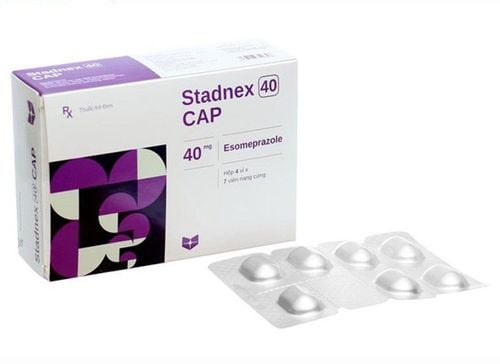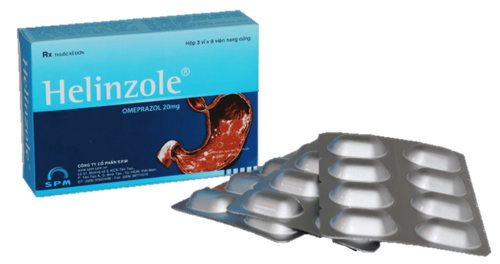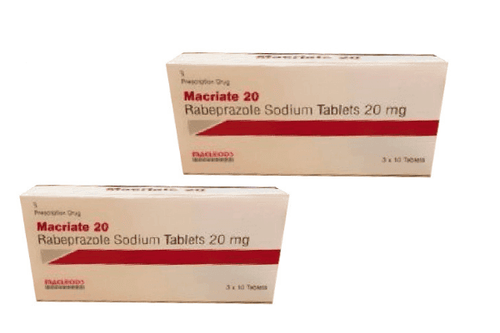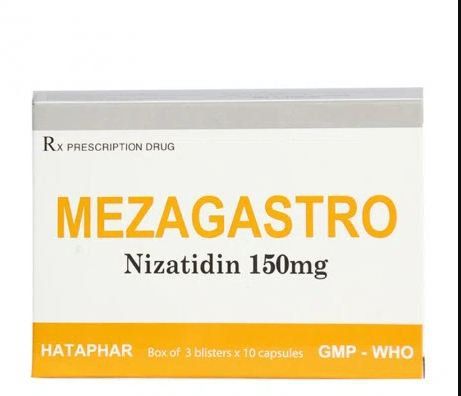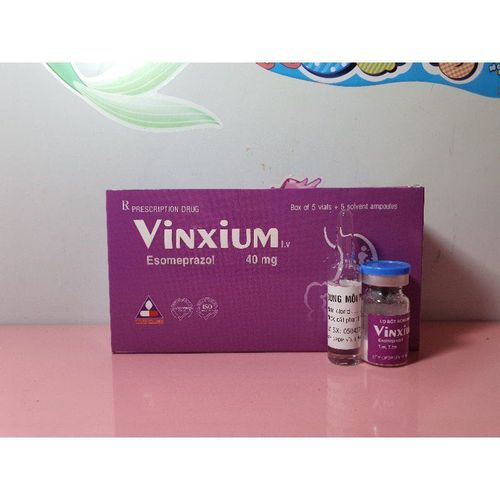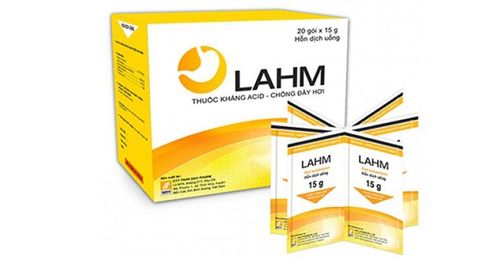This is an automatically translated article.
Rabofar 20 mg drug is used to treat gastric reflux, stomach ulcers. The main ingredient of the drug is Rabeprazole. Let's learn more about the Rabofar 20 drug line through the following article.
1. What is Rabofar?
Rabofar drug belongs to the group of gastrointestinal drugs. In each Rabofar tablet with the main ingredient is Rabeprazol sodium 20mg content and other excipients such as: Mannitol, Magnesium oxide heavy, L- Hydroxypropylcellulose, Methacrylic acid, Hydroxypropylcellulose, Magnesium stearate, Ethylcellulose, Ferric oxide yellow, Copolymer type C 30 %,Titanium dioxide, Talc, Triethyl citrate.
The drug is researched and manufactured at Kwality Pharmaceutical PVT. Ltd. - INDIA.
2. Indications for taking Rabofar
Rabofar drug is used in the following cases:
Treatment of gastric ulcer Duodenal ulcer Anastomosis ulcerative esophagitis caused by reflux esophagitis Zollinger-Ellison syndrome Combined with other antibiotics in the eradication treatment regimen HP in patients with duodenal ulcer. Rabofar should not be used in the following cases:
Patients with hypersensitivity to the ingredient Rabeprazole sodium or derivatives of benzimidazoles or any of the active ingredients in the drug. Rabofar should not be used in children, pregnant women and nursing mothers.
3. Dosage and how to use Rabofar
Rabofar is in the form of tablets and is taken orally. Patients should take the tablet whole, do not chew, crush or break the tablet, can take it when full or hungry.
Patients can refer to the following dose of Rabofar. Note that the doses below cannot replace the dose listed on the leaflet for Rabofar or the dose prescribed by your doctor or pharmacist.
Adults: 10mg Rabeprazol / day, can increase to 20mg Rabeprazol / day depending on the progression of the disease. Duration of treatment is 4 to 8 weeks for duodenal ulcer and 6 to 12 weeks for gastric ulcer and reflux esophagitis. Stomach and duodenal ulcers: The usual dose is 20mg of Rabeprazole, taken as a single dose in the morning. The duration of drug treatment depends on the severity of symptoms. Most people with duodenal ulcers heal within 4 weeks. However, some patients may need an additional 4 weeks of treatment to reach the healing stage. Most people with peptic ulcers and reflux esophagitis heal within 6 weeks. However, some patients may need an additional 6 weeks of treatment to reach the healing stage. Gastroesophageal reflux esophagitis: The recommended dose is 20mg of Rabeprazole, taken once a day for 4-6 weeks. Zollinger-Ellison syndrome: The starting dose is 60mg of Rabeprazole, once a day. The dose may be increased to 120 mg of rabeprazole/day depending on the patient's response. Single daily dose up to 100mg of Rabeprazole/day, with a dose of 120mg of Rabeprazole/day, it is necessary to divide 60mg of Rabeprazole/time x 2 times/day. H. pylori eradication: Patients infected with H. pylori should be used in combination with other drugs Clarithromycin 500mg 2 times/day + Rabeprazole Sodium 20mg 2 and amoxicillin 1g, 2 times/day. Rabeprazole treatment lasts 7 days. It has been reported in clinical trials that single doses of Rabeprazole 786 mg/kg and 1024 mg/kg resulted in death in mice and rats. However, a dose of 2000 mg/kg body weight did not cause death in dogs when tested.
Common manifestations of overdose are respiratory depression, repeated diarrhea, panic attacks and coma when tested on dogs.
If a patient who overdoses on Rabofar shows a coma or is unable to breathe, immediately call the emergency center for timely treatment.
4. Rabofar drug interactions
When combined with Rabofar drug with the following drugs, there may be drug interactions such as:
Rabofar drug increases the concentration of Digoxin in the blood and may prolong the metabolism and excretion of phenytoin. Co-administration of Rabeprazole with Ketoconazole or Itraconazole may reduce the absorption of Ketoconazole or Itraconazole. Therefore, if used, it is necessary to monitor and adjust the dose of these two drugs. Avoid concomitant use of Rabeprazol with drugs Nelfinavir, Erlotinib, Delavirdin, Posaconazole. Co-administration of Rabeprazole with Atazanavir 300 mg or Ritonavir 100 mg and Rabeprazole sodium 40 mg/day single dose or Atazanavir 400 mg with lanzoprazole 60 mg/day single dose in healthy volunteers showed a significant reduction in Atazanavir concentrations. The absorption of Atazanavir is pH dependent. Therefore, the concomitant use of Rabeprazole with a proton pump inhibitor is not indicated. Rabeprazole may decrease the concentration/effect of Atanazavir, Chlorpidogrel, Dabigatran, Etexilat, Dasatinib, Eriotinib, Indinavir, iron salts, Itraconazole, Ketoconazole, Mesaiamin, Mycophenolate, Nelhnavir. Rabeprazole may increase the concentration/effect of drugs that are substrates CYP2C19, CYP2C8 (high risk), Methotrexate, Saquinavir, Voriconazole. Digoxin when taken with Rabeprazole can increase the concentration of digoxin in the blood. Phenytoin in combination with rabeprazole may prolong the metabolism of phenytoin. Antacids may decrease the serum concentration of Rabeprazole when used in combination. Methotrexate: Concomitant administration of rabeprazole with methotrexate may increase plasma concentrations of methotrexate and its metabolite hydroxymethotrexate. To ensure safety when using Rabofar, patients should list all the drugs they have been using or have other medical conditions for the doctor to have a reasonable medication direction to avoid possible interactions. happen.
5. What side effects does Rabofar cause?
During the use of Rabofar medicine, patients may experience some unwanted side effects such as:
Skin urticaria, rash, itching, itching, erythema Hematologic changes, polymorphonuclear leukopenia neutropenia, leukopenia, thrombocytopenia, leukocytosis gas, anorexia Stevens-Johnson syndrome. Hyponatremia Peripheral edema Gynecomastia in men. Inform your doctor or pharmacist of any side effects that the patient experiences while using Rabofar.
6. Precautions when using Rabofar
Before using Rabofar to treat patients, please carefully refer to the following notes.
Before taking Rabofar, it is necessary to exclude the possibility of malignancy of gastric ulcer. People with liver failure. Rabeprazole use may cause interstitial nephritis. Long-term treatment with rabeprazole can lead to malabsorption of cyanocobalamin (vitamin B12), increase the risk of osteoporosis, cause diarrhea, and fractures involving the hip, spine, or wrist. Therefore, patients should take Rabeprazole at the lowest dose for the shortest time. For patients who are on long-term treatment for more than 1 year, they should be supervised by the treating doctor. There are no dosage guidelines for Rabofar for children due to lack of experience in this group. There was no significant change in the study in patients with mild or moderate hepatic impairment compared with the control group, so there is no need to reduce the dose of Rabeprazole in this subject. The possibility of malignancy should be excluded before treatment with Rabeprazole because the drug may mask the symptoms of gastric cancer. If during the course of taking Rabeprazole, the patient has sun damage to the skin exposed to the sun accompanied by joint pain, the patient should promptly consult a doctor and should consider discontinuing the drug. Interfere with tests: Increased levels of Chromogranin A (CgA) may interfere with the investigation of neuroendocrine tumors. Therefore, Rabeprazole treatment should be discontinued at least 5 days before CgA measurement. If gastrin and CgA levels and do not return to the reference range after the initial measurement, the measurement must be repeated 14 days after stopping proton pump inhibitor therapy. Rabofa medicine can cause side effects such as drowsiness, so it may affect the ability to drive or operate machines, patients should be cautious when using this medicine.
Please dial HOTLINE for more information or register for an appointment HERE. Download MyVinmec app to make appointments faster and to manage your bookings easily.




